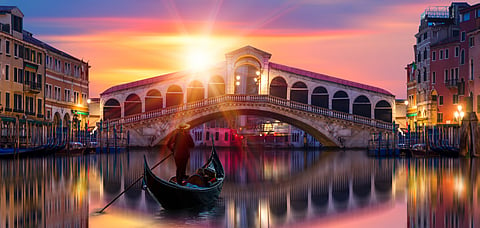
- Destinations
- Experiences
- Stay
- What's new
- Celebrating People
- Responsible Tourism
- CampaignsCampaigns
- Subscribe
- Buy Now

Venice marks its 1600th anniversary this year. And it is marking the event with a new project that will help monitor the number of tourists it gets every year.
In the city of canals, also known as La Serenissima or The Most Serene, tourists outnumber local residents by a huge margin.
In a bid to change the course of tourism for the better, Venice has started watching and tracking the move of every tourist entering the city. They count them in as they enter the city, and as they leave it. They are also keeping track on when and where tourists move about in the city, and when they slow down or speed up.
By tracking the phones of tourists, they can determine the number of people arriving from an area, country or region. This decision to track tourists was taken in the pre-COVID era and is being implemented now.
Due to the excessive traffic of tourists in recent years, the beautiful city of blue waters and ancient architecture has become much less serene. Almost 30 million tourists descend every year in the city of just 50,000 inhabitants, choking the streetways and canals. Authorities previously tried to implement some regulations such as separate resident lanes and a planned &lsquoentrance tax&rsquo which was to debut in 2020 (now postponed to January 2022) to filter locals from tourists on a busy day.
In a city where the vast majority of tourists are day trippers and not overnight stayers, it becomes difficult to keep track and register them all. But Venice has developed a technology which will enable that. The system took three years to build at a cost of three million euros ($3.5m). The obvious concerns about privacy have been raised, but officials say the system ensures that no personal data is ever recorded. The phone data of tourists is analysed and the information is all aggregated automatically, so personal details cannot be gleaned.
The system feeds data to the authorities to help create a profile of the hordes visiting the city. The data in turn helps the authorities to activate turnstiles at visited places, so they can start levying entrance fees on busy days. The system can also count the hit-and-run tourists who do most damage to the struggling city (day tourists who barely bring in money or stay overnight). The overtourism control room opened in October 2020 on the island of Tronchetto.
Eventually, officials say that the system will help them in planning a sustainable tourism model for Venice.
The system is also being used to monitor the tide levels throughout the lagoon. This is crucial for monitoring acqua alta flooding, and determining when the new Mose flood barriers should be raised. The billion-euro Mose project was first designed in 1984 and had to pass through delays, corruption, and cost overruns before finally getting approved for construction in 2003.
Part of the project is a steel wall with 78 yellow flood gates. It is inflatable, moveable, and designed to protect the Venetian lagoon from 10 feet (three meters) high tides.
